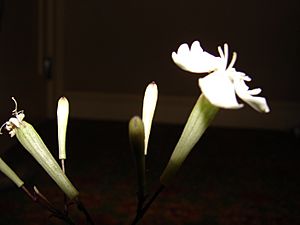Kamalo Gulch catchfly facts for kids
Quick facts for kids Kamalo Gulch catchfly |
|
|---|---|
 |
|
| Conservation status | |
| Scientific classification | |
| Genus: |
Silene
|
| Species: |
alexandri
|
Silene alexandri is a very rare flowering plant. It is also known as the Kamalo Gulch catchfly or Alexander's catchfly. This plant belongs to the Caryophyllaceae family, which includes many types of flowers. It grows only in Hawaii, specifically on the island of Molokai. Because it is so rare, the United States government lists it as an endangered species. This means it is in danger of disappearing forever.
Contents
About the Kamalo Gulch Catchfly
This plant is a small subshrub, which is like a small bush. It usually grows to be about 30 to 60 centimeters tall, which is roughly the height of a ruler or two. When it blooms, it has pretty white flowers.
Where Does it Live?
Silene alexandri likes to grow in wet, low-lying areas. It is often found in shrublands on the sides of steep basalt cliffs. Basalt is a type of volcanic rock. This plant is endemic to Molokai. This means it naturally grows nowhere else in the world.
For a long time, this plant was only found along a four-kilometer stretch of Molokai. Sadly, today, scientists believe there is only one small group of these plants left. This group has only about six individual plants.
Why is Silene alexandri Endangered?
The main reason Silene alexandri is in danger is because its home is being damaged. Many different things are hurting its natural habitat.
Threats from Other Plants
One big problem comes from invasive species. These are plants that were brought to Hawaii from other places. They grow very fast and take over the space and resources that native plants need. Some of these harmful plants include:
- Lantana (Lantana camara)
- Molasses grass (Melinis minutiflora)
- Natal grass (Rhyncelytrum repens)
These introduced plants make it hard for Silene alexandri to grow and thrive.
Damage from Animals
Another threat comes from feral goats. These are goats that used to be farm animals but now live in the wild. They eat the plants and walk all over the habitat. This damages the area where Silene alexandri lives.
Challenges with Reproduction
Because there are so few Silene alexandri plants left, they face a big challenge with reproduction. When there are only a few individuals, it becomes harder for them to find partners to reproduce with. This can lead to a loss of "reproductive vigor," meaning the plants might not be as strong or healthy when they do reproduce. It also makes it harder for the population to grow back.


